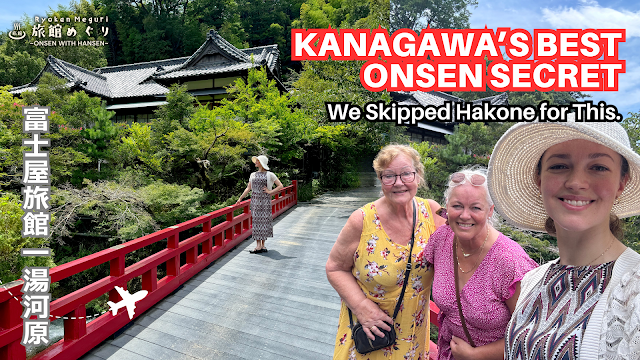Why Locals Choose This Hidden Onsen Over Hakone | Fujiya Ryokan, Yugawara
Looking for an authentic onsen ryokan experience close to Tokyo, but without the tourist crowds of Hakone?
Let me introduce you to Fujiya Ryokan (富士屋旅館) — a historic hot spring inn in Yugawara, Kanagawa, that’s quietly become one of my all-time favorite getaways.
🏯 A Ryokan Steeped in History
Established in 1876, Fujiya Ryokan is one of Yugawara’s oldest traditional inns. The current main building, constructed in 1923, is a beautifully preserved Taisho-era wooden structure and is officially registered as a Tangible Cultural Property of Japan. Staying here feels like stepping back in time — but with all the comforts of a modern stay.
I visited with my mother and grandmother in late summer, and it turned out to be the perfect multi-generational escape. From the timeless architecture to the soft rustle of yukata in the halls, everything about Fujiya Ryokan speaks to the kind of understated luxury that Japan does so well.
♨️ Onsen for Mind and Body
Fujiya’s onsen baths are gender-separated and indoor, but don’t let that fool you — the atmosphere is just as soothing as any open-air rotenburo. With natural hot spring water drawn from Yugawara’s renowned sources, the baths offer a skin-softening experience in a calming, wood-framed space that feels timeless.
🍽️ Kaiseki with a Twist: Unagi Specialties
One of Fujiya Ryokan’s biggest surprises was the food. Dinner is served at their restaurant Hyōrokutei (瓢六亭) and features beautifully curated kaiseki cuisine made from seasonal ingredients.
Their unagi (eel), however, is what sets them apart. Served Kansai-style—grilled without steaming—it arrives crispy on the outside, tender on the inside, and full of smoky, savory depth. It’s presented in a traditional donabe (clay pot) over rice, making the experience even more memorable.
🌸 Perfect for a Peaceful Stay — Without the Hakone Prices
Yugawara often flies under the radar, sitting just before the more famous onsen resort of Hakone. But locals in the know often choose Yugawara instead. Why?
-
It’s less crowded,
-
Often more affordable, and
-
Home to hidden ryokan gems like Fujiya.
Whether you’re a solo traveler, a couple on a quiet retreat, or a family spanning generations like mine, this ryokan offers something rare: a chance to slow down and soak in Japan’s natural and cultural beauty without distraction.
▶️ Watch the Full Video
🎥 I captured our entire experience at Fujiya Ryokan on video!
▶️ Watch here: Why Locals Choose This Hidden Onsen Over Hakone | Fujiya Ryokan Yugawara
Get a closer look at the historic rooms, serene onsen baths, beautifully presented meals, and the surrounding charm of underrated Yugawara.









![[Hotel Review] Manila: A night at the Hotel H2O Aquarium Hotel](https://blogger.googleusercontent.com/img/b/R29vZ2xl/AVvXsEhr6Htjs5IkrblDNSVvN1nJq2VqYSfzGeM1ITy7xpQLjOt20kiZnCd1NHLKeavoQ-BOCUVp8ciWn-hykaK6LmWjsmEH1OM6RMz8qJzRNNtYfh6T-xtDT8s_GJSeeqjPNgQVdkB_wi9dZIiz/w72-h72-p-k-no-nu/IMG_5062.JPG)






